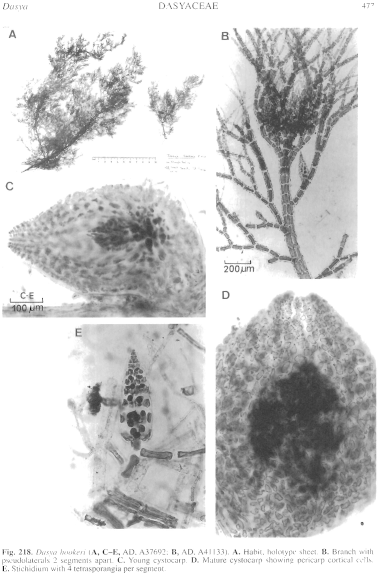|
|
|
|
|
|||||||||||
|
Electronic Flora of South Australia Species Fact Sheet
Phylum Rhodophyta – Order Ceramiales – Family Dasyaceae
Thallus (Fig. 218A) medium to dark red to grey-red, 5–30 cm high, profusely branched with several axes and main branches bearing lesser branches with slender lateral pseudolateral tufts, becoming denuded below. Attachment probably by tufts of rhizoids; epiphytic on Amphibolis, Posidonia, Sargassum and other algae. Structure. Apices sympodial. Pericentral cells 5, remaining clear in transverse section and without surrounding rhizoids. Lesser branches (50–) 100–300 µm in diameter with segments L/D 0.8–1.2, becoming corticate from 10–20 segments below apices, cortication complete below and 2–5 cells thick where axes are 500–1000 µm in diameter with segments L/D 0.5–1. Pseudolaterals mostly 2 axial cells apart (Fig. 218B), 1–2 mm long with 2–5 (–7) lower subdichotomies usually 2 cells apart, with adherent joint lower walls and unbranched ends 6–12 cells long; basal cell short, lower cells 35–90 (–110) µm in diameter and L/D 2–7, tapering markedly but evenly to upper cells 8–12 µm in diameter and L/D 6–15. Lateral branches arising from basal cells of pseudolaterals. Rhodoplasts discoid to elongate, becoming chained in larger cells.
Reproduction: Gametophytes dioecious. Procarps not observed. Young carposporophytes with cells at base darkly staining, carposporophytes much branched, with a basal fusion cell, carposporangia in rows, ovoid, 12–20 µm in diameter. Cystocarps (Fig. 218C, D) ovoid, 0.4–1.2 mm in diameter with a slight neck, sessile on short lateral branches with the pericarp often enclosing the continuing branch. Pericarp (Fig. 218D) with 12–14 erect filaments, the cells cutting off outwardly irregularly shaped cells and occasional smaller corticating cells.
Spermatangial branches borne as branches of pseudolaterals, sessile, 90–140 µm long and 30–45 µm in diameter, with 1–3 sterile apical cells.
Tetrasporangial stichidia (Fig. 218E) borne on lower cells of pseudolaterals, sessile, lanceoid, (100–) 200–500 µm long and (50–) 90–140 µm in diameter, with 5–12 fertile segments each with 4 tetrasporangia, subspherical and 25–35 µm in diameter and 2 ovoid to obloid cover cells.
Type from off West Beach (Adelaide), S. Aust., on Amphibolis, 6 m deep (Shepherd, 13.xi.1970); holotype sheet (female, tetrasporangial) in AD, A37692.
Selected specimens: Hopetoun, W. Aust., epiphytic, 3–4m deep (Kraft 6985 & Ricker, 16.viii.1979; MELU and AD, A67884). Sturt Bay, Yorke Pen., S. Aust. (Davey; AD, A1478). Douglas Bank, N Spencer Gulf, S. Aust., 8 m deep (Shepherd, 6.ix.1973; AD, A44474). St Kilda, S. Aust., 3–4 m deep (Wickes, 3.v iii.1973; AD, A43782). Henley Beach, S. Aust., drift (Parsons, 7.xi.1969; AD, A34423). N of Aldinga, S. Aust., on Posidonia, 7 m deep (Johnson, 10.viii.1973; AD, A43914). American R. inlet, Kangaroo I., S. Aust., sublittoral (Womersley, 2.xii.1947; AD, A6171) and 2–4 m deep (Min-Thein, 2.xii.1971; AD, A41133). Lacepede Bay, S. Aust. (Engelhart, 1897; AD, A1469). Port Arlington, Port Phillip, Vic., 0–2 m deep on jetty piles (Womersley, 9.viii.1959; AD, A23110). Flinders, Vic., on Amphibolis, 1–3 m deep (Kraft 6236, 23.xi.1976; MELU and AD, A56319). Crawfish Rock, Westernport Bay, Vic., 3–6 m deep (Watson, 15.ix.1968; AD, A32866). Lady Barron, Flinders I., Bass Strait (Perrin, June 1949; AD, A48199). Currie R., N Tas., drift (Perrin, Jan. 1940; AD, A8480). White Beach, Wedge Bay, Tasman Pen., Tas., upper sublittoral (Wollaston & Mitchell, 29.ii.1964; AD, A27679). Port Arthur, Tas. (Cribb 48.1, 29.iii.1950; AD, A15991).
Distribution: Hopetoun, W. Aust., to Western Port, Vic. and Flinders I., Bass Strait, and N and E Tasmania.
Taxonomic notes: Dasya hookeri is named after J.D. Hooker who contributed significantly to knowledge of Tasmanian algae. It is closest to D. capillaris, differing in having much coarser (basally) pseudolaterals. It occurs in relatively sheltered waters and has often been confused with D. capillaris (e.g. Harvey specimens from Georgetown, Tas., as D. capillaris, include D. hookeri as well as D. crescens).
References: The Marine Benthic Flora of Southern Australia Part IIIC
Publication:
Womersley, H.B.S. (24 December, 1998)
The Marine Benthic Flora of Southern Australia
Rhodophyta. Part IIIC. Ceramiales – Ceramiaceae, Dasyaceae
©State Herbarium of South Australia, Government of South Australia
Illustration in Womersley Part IIIA, 1998: FIG. 218.

Figure 218 enlarge
Fig. 218. Dasya hookeri (A, C–E, AD, A37692; B, AD, A41133). A. Habit, holotype sheet. B. Branch with pseudolaterals 2 segments apart. C. Young cystocarp. D. Mature cystocarp showing pericarp cortical cells. E. Stichidium with 4 tetrasporangia per segment.

|
Email Contact: State Herbarium of South Australia |

|